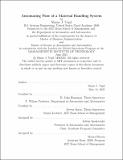| dc.contributor.advisor | R. John Hansman. | |
| dc.contributor.advisor | Steven Spear. | |
| dc.contributor.author | Vigil, Shane J. | |
| dc.contributor.other | Sloan School of Management. | |
| dc.contributor.other | Department of Aeronautics and Astronautics. | |
| dc.date.accessioned | 2022-01-10T21:07:55Z | |
| dc.date.available | 2022-01-10T21:07:55Z | |
| dc.date.issued | 2021 | |
| dc.identifier.uri | https://hdl.handle.net/1721.1/138870 | |
| dc.description | Thesis: M.B.A. Massachusetts Institute of Technology, Sloan School of Management, June, 2021 | |
| dc.description | Cataloged from the official PDF version of thesis. | |
| dc.description | Includes bibliographical references (pages 71-73). | |
| dc.description.abstract | Amazon uses a system of interconnected manned work processing stations linked by conveyances that route items from different parts of the warehouse into a single order for packing. This thesis will examine one such system, which circulates items throughout the system in trays. Leaders manage and tune the production rate by adjusting the number of trays within the system to maximize throughput. This task takes considerable time and requires operators to manually add and remove trays from the system. To reduce time spent by leaders in managing trays, automated solutions are investigated. It is determined that the optimal number of trays within the system is dynamic. Furthermore, physical constraints of the system prevent an automated solution that simply inserts and removes trays based off an algorithm. This study uncovers unrealized throughput by creating a model of the system that outputs the ideal tray count based off historical data and mathematical constraints. Additionally, this thesis explores an automated solution that supplies and removes trays based off localized blockage and starvation.
A Work Domain Analysis and a human factors study laid the foundations for automation. Simulation demonstrates the potential for a 21.2% production rate increase and a release of 7.14 hours/day for other tasks. Implementation of the model with an alert system increases throughput 20% during maximum production with a median error of 8.11% when targeting a desired throughput. These techniques can be extended to other circulation systems in manufacturing. As Industry 4.0 grows, the management of human-machine relations becomes critical for safety and performance. | en_US |
| dc.description.abstract | A Work Domain Analysis and a human factors study laid the foundations for automation. Simulation demonstrates the potential for a 21.2% production rate increase and a release of 7.14 hours/day for other tasks. Implementation of the model with an alert system increases throughput 20% during maximum production with a median error of 8.11% when targeting a desired throughput. These techniques can be extended to other circulation systems in manufacturing. As Industry 4.0 grows, the management of human-machine relations becomes critical for safety and performance. | |
| dc.description.statementofresponsibility | by Shane J. Vigil. | |
| dc.format.extent | 73 pages | |
| dc.language.iso | en_US | en_US |
| dc.publisher | Massachusetts Institute of Technology | en_US |
| dc.subject | Aeronautics and Astronautics. | en_US |
| dc.subject | Sloan School of Management. | en_US |
| dc.title | Automating Flow of a Material Handling System | en_US |
| dc.type | Thesis | en_US |
| dc.description.degree | M.B.A | |
| dc.description.degree | S.M. in Aeronautics and Astronautics | |
| dc.contributor.department | Sloan School of Management | |
| dc.description.collection | M.B.A Massachusetts Institute of Technology, Sloan School of Management | |
| dc.description.collection | S.M. in Aeronautics and Astronautics Massachusetts Institute of Technology, Department of Aeronautics and Astronautics | |
